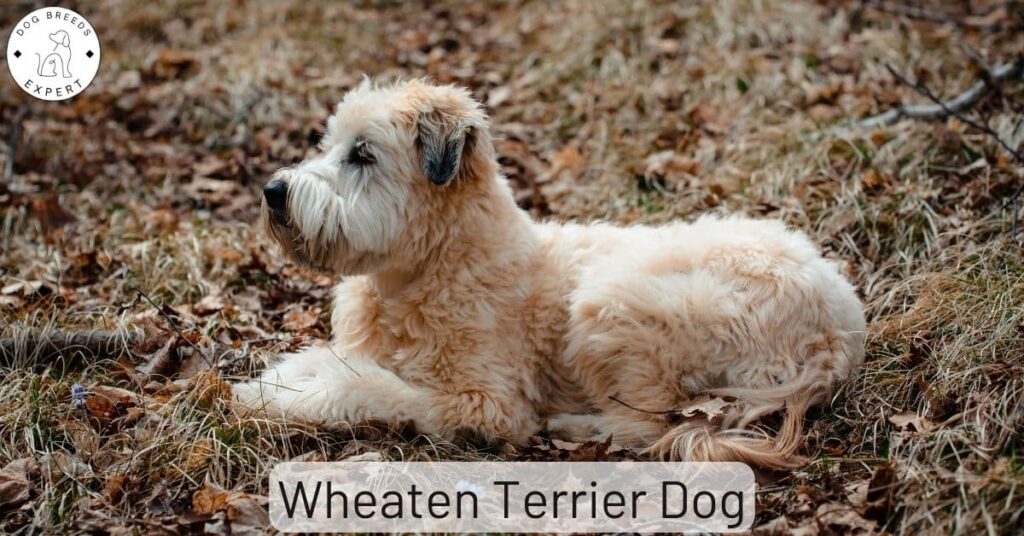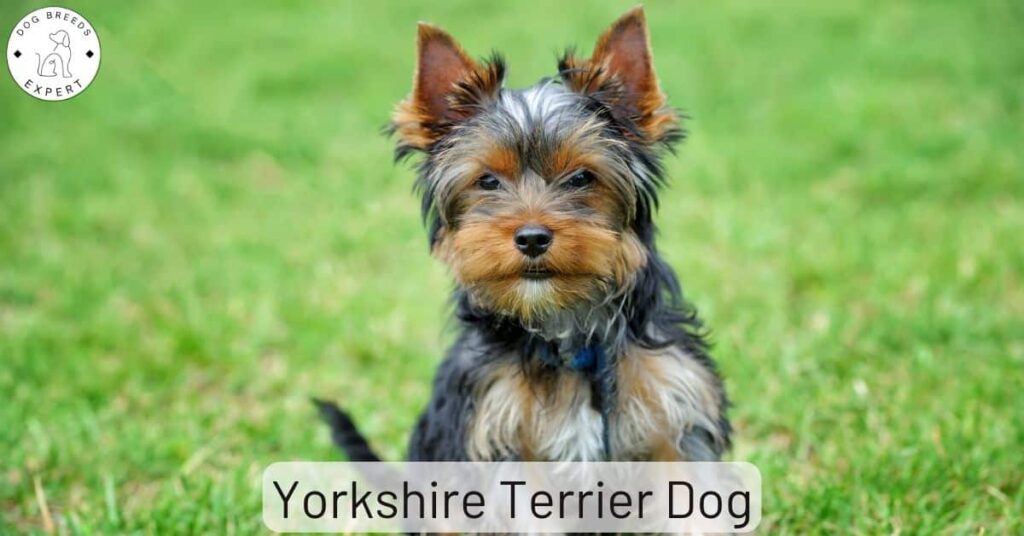An Ancient American Breed
The Alaskan Malamute is the biggest and the most ancient of the Arctic sled dog breeds. They can be traced back over 4,000 years to an Inuit tribe called the Mahlemuts in Alaska.
While they are known as athletic dogs, they are best at endurance rather than outright speed, which comes from their heritage pulling heavy loads on sleds over long distances. This has resulted in a breed that needs adequate daily exercise. They were also expected to deter and chase off polar bears.
The Alaskan Malamute is an active, loyal breed that loves to be treated as a family member. These dogs are hardworking and have plenty of energy to play or exert through heavy exercise. Wonderful dogs! Malamute young puppies normally cost from $1,000 to $2,000.
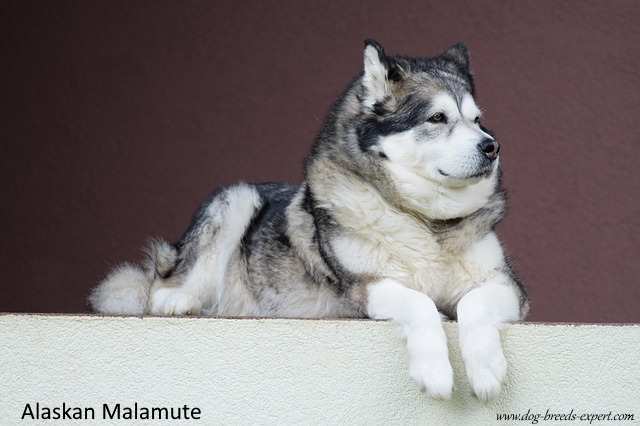
Alaskan Malamute – Temperament
These are pack animals. That means they prefer to be in a pack or a family, and enjoy company.These traits served them well as they pulled sleds and people from one cold arctic town to another.
They are happiest when participating with their owners or dogs of their own pack. At the same time, they thrive when given a job that allows them to use up their excess energy.
Their energetic personality is important to take into account when thinking about getting one, as they will get into some bad habits if they are forced to stay cramped up in their home.
This large dog is loyal and happy to be around its family, however, they are not very well suited to sharing the house with other dogs. While they tend to coexist better with dogs of their own breed, it’s recommended that they have lots of space to move around in.
Unknown dogs will be treated with wariness and are not likely to be welcome to the property. Due to their natural instinct to hunt, given their ancient background as a breed, they’ll look at most small animals as prey, not excluding smaller dogs or cats from the list of various neighborhood creatures.
They must be trained well to live with other animals.
Despite their inhospitable approach towards other animals, they are quite warm towards strangers. They will happily greet whoever, whether they are welcomed onto the property or not.
They are not suited for deterring any unwanted company, despite their intimidating appearance. Due to their vocal personality paired with their need to spread out and exercise, a confined, quiet habitat is not at all appropriate for this breed.
This breed is very sensitive to the way it is treated, with its behavior a direct reflection of its owner’s treatment. These dogs have a natural instinct to claim the position as leader of the pack if it appears up for grabs.
An owner must display an air of superiority and be a strong leader if they hope to train these dogs at all. An Alaskan Malamute may walk all over any owner that they perceive as weak.
Alaskan Malamute
Alongside their sensitive personality comes their sensitivity to heat, as these dogs were evolved to survive in cold environments. Their thick coats are perfect for life in cold climates, but are not suited to hot climates.
During particularly warm weather, they should avoid extensive exposure to the heat, and keep well hydrated.
The Alaskan Malamute is not the best dog to be sharing a house with children. While their demeanor towards older, teenage children is not dissimilar to that of an adult, younger children are at risk of injury.
Due to the breed’s energetic personality paired with its strong, sturdy build, it’s easy for a small child to be knocked over or become scared.
Children should always be monitored when playing with these dogs, as well as taught the proper way to handle them beforehand.
The Malamute is famous for its vocal behavior, particularly its unusual howl-like babble. When they’re not wooing your guests, they’re legitimately “wooing”.
They’ll howl at whatever they find curious or unusual, as well as the presence of a person or creature. They are not recommended for urban locations. It is also best that they are not near any neighbors that are particularly sensitive to high volumes.
The Alaskan Malamute has the energy and determination to explore all day if nothing is stopping them. Their inclination to spread out and explore the neighborhood comes from their days exploring vast chunks of the Alaskan wilderness.
Due to the breed’s size, it’s not likely that a small electric fence could keep them from chasing after anything they find interesting, whether it be a car or a squirrel. It’s recommended that they have a sturdy fence to keep them from bolting into the street or running off.
The Alaskan Malamute is also notorious for its love to dig. Without supervision, a malamute will dig up your entire yard.
This love to dig is profoundly ingrained, with most owners resort to providing a designated “dig” space rather than attempting to train them otherwise. If you don’t plan on having extra canine help the next time you go planting in your garden, it’s important to take this into consideration.
History
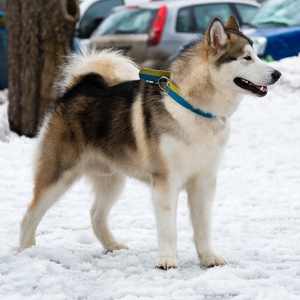
The Alaskan Malamute is well known for being a very old breed. It is believed that these dogs are among some of the earliest that separated dog from a wolf, a factor that is often very apparent from the breed’s appearance, similar to a Siberian Husky.
It’s most likely that these dogs migrated along with the first humans that crossed over the land bridges that connected the Americas with Asia around two or three thousand years ago.
These dogs continued to thrive as they coexisted with Native American tribes near and inside the Arctic Circle.
Their name originates from the Mahlemut tribe that resided in Alaska, with whom they shared the mutual benefits that allowed them to survive to the present day.
These humans and dogs lived in harmony for a long time before they encountered any foreign contact, assisting their tribes in hunting game and helping to defend them from wild polar bears.
The Alaskan Malamute remained in Alaska until the discovery of gold in the state at the very end of the 19th century. Due to that finding, many people from all over the world flocked to the area in hopes of becoming rich.
These foreigners were promptly greeted by the harsh conditions of the Arctic, prompting them to adapt where they could to survive. When it came to hauling equipment, they turned to dogs as a more versatile form of transport.
Many of the dogs brought by these people were mixed with the dogs local to Alaska, including the Alaskan Malamute. It was only the breed’s isolation that kept it from being thoroughly mixed and disappearing altogether.
Many of the dogs brought by these people were mixed with the dogs local to Alaska, including the Alaskan Malamute. It was only the breed’s isolation that kept it from being thoroughly mixed and disappearing altogether.
These dogs were put to work pulling sleds for people traveling the vast terrain, a job they were well suited for with their sturdy build. The use of dog-sledding continued for a long while due to its efficiency and practicality.
Most of the Alaskan gold rush had been centered in the town of Nome, where many gold miners set themselves up in hopes of getting lucky.
However, due to the town’s isolation and its harsh climate, it was vacated by many of its new residents just as quickly as they arrived.
Alaskan Malamute Breed History
The Alaskan Malamutes have a prominent part in the town of Nome’s survival. During a disease outbreak in 1925, it was the dogs’ transportation of necessary supplies and medicine that saved many of the town’s people from dying.
The breed remained in Alaska for the most part. Few left the state. They were first registered by the AKC in 1935, allowing for a standard and a base of these dogs to begin a stable population recovery.
These dogs continued to prosper until World War 2, when a military expedition to Antarctica proved almost fatal to a large group of Alaskan Malamutes. They had been requisitioned by the military.
It was only the public outrage from the men involved that prevented their senior officers from killing the dogs.
After the war, the Alaskan Malamute was allowed to slowly rebuild its lost population. Due to the AKC’s standard and base of dogs before the war, they were able to repopulate the breed.
This was just in time for the post-war economic boom felt by the United States. The better economy allowed for a higher quality of living, which inevitably meant an increase in keeping dogs as pets.
Today, the breed holds the rank as the 55th most popular dog in the US according to the AKC.
Alaskan Malamute – Ease of Training
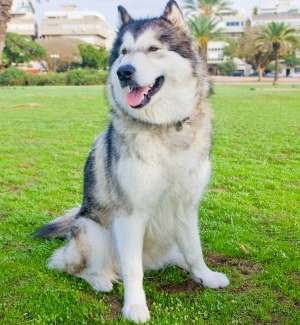
The Alaskan Malamute is a notoriously difficult dog to train, as its intelligence and pack mentality pair up in a very stubborn fashion.
They are not recommended for new dog owners, as they will take advantage of any owner that does not assume the position of pack leader. Instead, these dogs will adopt that position themselves, making them almost impossible to train.
Once their attention has been gained, however, these dogs are incredibly intelligent and fast learners. They are very sensitive as to how they are being trained, so their teaching must be consistent, or else they will take advantage of any leniency.
These dogs are well behaved once they have given the role of alpha to their owner. Basic housebreaking is often straightforward, with their main distractions coming from digging or chasing prey.
Early socialization is crucial in the training process, so many owners will recommend frequent walks and introductions to new people and other animals. Socializing any dog early on will help them become more comfortable in their environments and more relaxed around strangers.
Vital Statistics
Average Lifespan: 12-15 Years
Average Normal Weight: 71-94 lbs. (32-43 kg)
Average Height: 22-26 in. (56-66 cm)
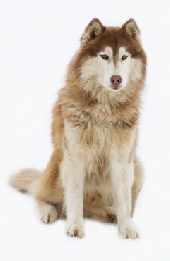
Colors
There are 9 colors registered by the AKC for this breed:
- Red and White
- White
- Silver and White
- Seal and White
- Agouti and White
- Black and white
- Sable and White
- Gray and White
- Blue and White
There are no markings registered for this breed.
Protection
These dogs are known for being an alert breed. While they may be a little wary of strangers at first, but they are also warm and welcoming to most people they encounter.
They may be able to tell that an intruder is on the property, but they also may not let their owners know due to their less vocal personalities.
This breed is not appropriate as a guard dog due to their friendly character. While they would be capable of defending their owner if push came to shove, they are mostly warm towards strangers.
They are not inclined to being territorial, and are not vocal enough to warn their owners of a possible threat.
All in all, these are NOT good watch dogs nor guard dogs.
Grooming
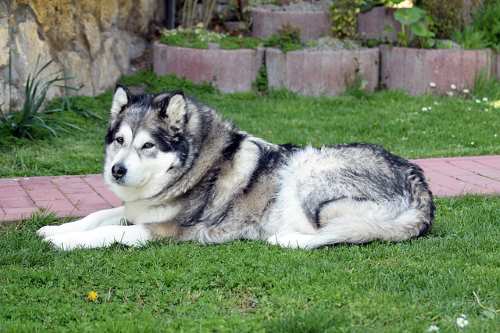
You will need to brush your Alaskan Malamute daily, as they have a very thick coat and shed a lot of hairs. To keep your pet healthy, regular brushing is essential – it is especially important to brush a dog with a double coat.
Brushing a dog’s teeth is just as important as maintaining their coat. Brushing a dog’s teeth on a regular basis will not only help keep their breath fresh but also remove bacteria and prevent tartar buildup, which leads to dental disease and infection of the gums.
Providing a dog with the proper dental care is essential for maintaining their health. Most owners recommend brushing these dogs’ teeth at least 2-3 times a week.
It is important to maintain a dog’s nails as well. Should a dog’s nails get to be too long, they may become uncomfortable or even painful.
To prevent discomfort, owners recommend clipping these dogs’ nails at least every 3 weeks, or as needed. A good way to tell if a dog’s nails are too long is if they can be heard clicking against the ground as they move.
Keeping a dog’s ears clean is an important part of the grooming process. Dogs’ ears can harbor bacteria that is caught and built up in their ear wax, leading to infections.
Owners recommend cleaning a dog’s ears at least once a week to remove excess wax. With the Alaskan Malamute, there is more airflow due to the shape of their ears, helping to prevent too much build up.
Health Conditions
You will want to take the best possible care of your pal.
As an owner, you must be willing to providing adequate health care, which includes more than the regular vet visit. You should have a preventive health plan which includes a dietary plan and an exercise plan, to avoid weight gain.
The Alaskan Malamute is a relatively healthy breed that has a long life expectancy. This being said, they are still susceptible to certain health problems, which should be considered when purchasing any purebred. While it is not inevitable that these dogs will be affected by any of these health problems, it’s best to be aware of them.
Important genetic predispositions;
- Inherited Polyneuropathy
- Hip Dysplasia affecting the hind legs
- Cataracts
- Chondrodysplasia
- Day Blindness or Hemeralopia
- Hypothyroidism
- Digestive disorders such as Bloat (Gastric dilatation)
- Heart disease and abnormal heart rhythms
- Immune system
It’s important to always purchase a purebred dog from a reputable breeder. Responsible breeders will know their breed inside and out. They should also be capable of passing health checks for their dogs, and getting hip x-rays and routine blood tests at the vet.
Famous Alaskan Malamutes
Balto: Famous Sled dog mentioned above
George Lucas’ dog, Indiana
Shasta, The Alaskan Husky that starred in Snow Buddies
Alaskan Malamutes from the movie, Eight Below
The Alaskan Malamute was registered by the American Kennel Club (AKC) in 1935, the same year that the Alaskan Malamute Club of America was formed.
You may also be interested in the Alaskan Malamute Club of America.
Further Reading
To find out more about this amazing breed click on the images below.


